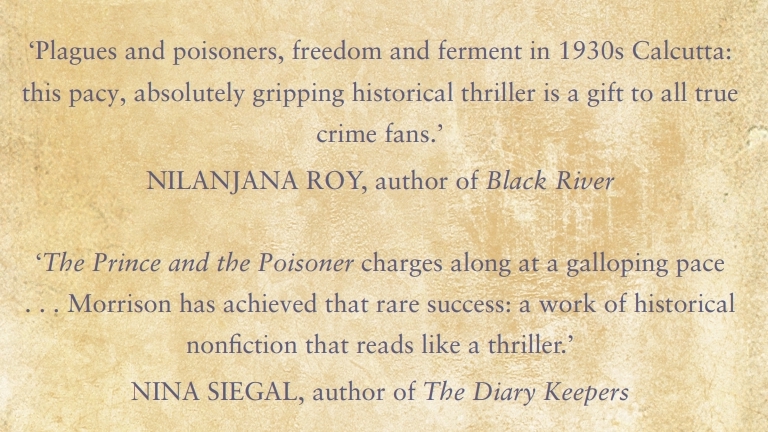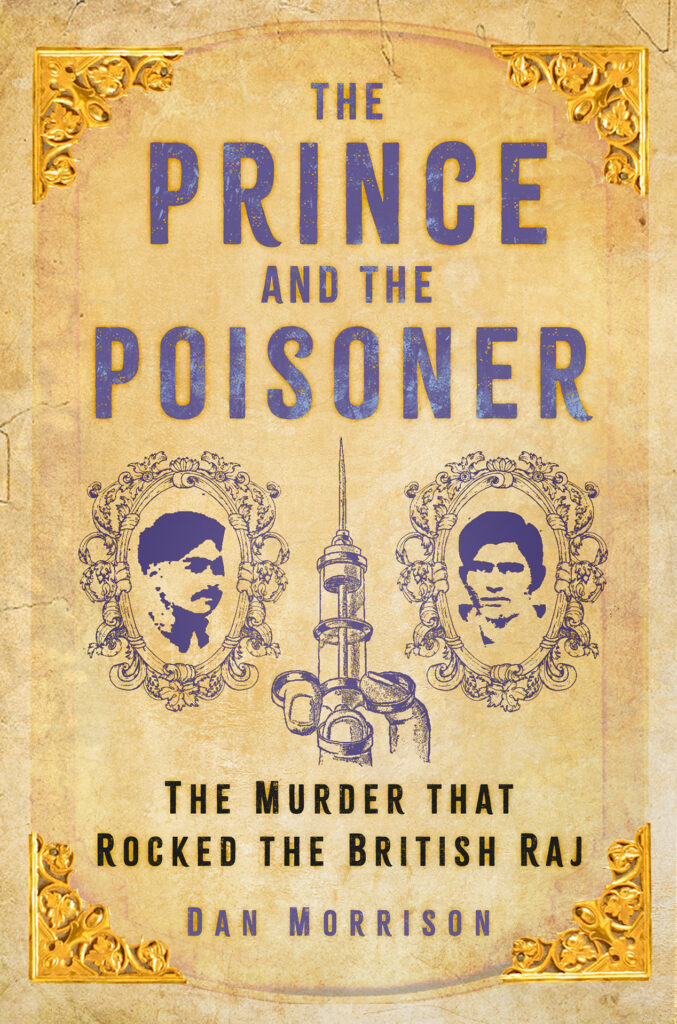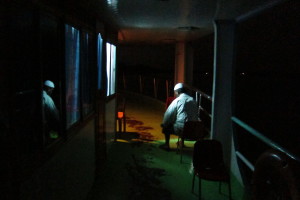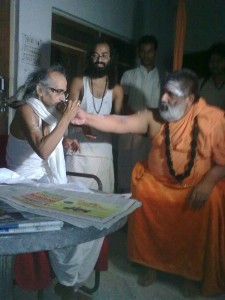I’ll be signing book and talking biocrime at the Chelsea Library in London on August 3. Come on down!


Journalist and author of The Prince and the Poisoner
I’ll be signing book and talking biocrime at the Chelsea Library in London on August 3. Come on down!


“Plagues and poisoners, freedom and ferment in 1930s Calcutta: this pacy, absolutely gripping historical thriller is a gift to all true crime fans.” – Nilanjana Roy, author of Black River
“Dan Morrison has unearthed a fabulous true crime story and embedded it within a fascinating work of micro history. David Grann has competition.” – Robert Twigger, author of Walking the Great North Line and Red Nile
“Right out of the gate, Dan Morrison’s thrilling narrative of greed, fratricide, and early 20th century forensics, The Prince and the Poisoner, charges along at a galloping pace. Synthesizing deep research with masterful storytelling skills, Morrison has achieved that rare success: a work of historical nonfiction that reads like a thriller. Your jaw may drop at what happened here, but you won’t want to look away.” – Nina Siegal, author of The Diary Keepers
 Here’s how Bangladesh took a hammer to extreme poverty in some of its poorest districts, for the low price of $12 a year per resident. The program is also the country’s first line of defense against global warming and rising seas. Read it in POLITICO Magazine, or the Dhaka Tribune.
Here’s how Bangladesh took a hammer to extreme poverty in some of its poorest districts, for the low price of $12 a year per resident. The program is also the country’s first line of defense against global warming and rising seas. Read it in POLITICO Magazine, or the Dhaka Tribune.
Two very different reports from my visit to the recently-concluded Maha Kumbh Mela in Allahabad, India, where tens of millions of pilgrims immersed themselves at the confluence of the Ganges, Yamuna, and (invisible) Saraswati rivers. For the New York Times, I looked at how India was able to eliminate of polio, using the Kumbh as a backdrop for this massive public health effort. And at Artforum, I looked at how artists approach this biggest of human gatherings. More soon.
Three from the NatGeo blog: On the trail of endangered pangolins from Africa to restaurants in China; wrestling as peacebuilding in South Sudan; and an unprecedented scientific investigation into neonatal death in Bangladesh, India, and Pakistan.
I wrote in the New York Times a few months ago about the takeover of the Gandhian Institute of Studies in Varanasi, India, by a clique of so-called “academics” tied to the right-wing Rashtriya Swayamsevak Sangh. The RSS, a paramilitary organization with an estimated 5 million members, “actually was the inspiration and source of the Kill Gandhi and Hate Gandhi movement” that led to Gandhi’s assassination, according to Tushar Gandhi, a great-grandson of the Mahatma.
It’s ironic, Tushar told me, that the RSS “is attempting to grab an institution founded by Ram Manohar Lohia, a eminent follower of Gandhi and one of India’s leading socialist leaders.”
Now comes news that the grounds of the Gandhian Institute have recently been used to host a meeting of RSS leaders. Clips (in Hindi) after the jump.
It’s a world of fakes and charlatans — they’re in every city in every country. But still: The Gall.
Continue reading “Hindu Right-Wingers Feasting in Gandhi’s Domain”
Aid organizations have long struggled with the issue of how to get donors engaged. Faced with the choice of making supporters feel they’re singlehandedly saving the world versus showering them with administrative details about vaccines, food, and emergency tarps, it’s not surprising many choose to emphasize the individual, be it your individual contribution, a single (usually famous) interlocutor, ala Nicholas Kristof or Angelina Jolie, or individual beneficiaries. People want to feel connected.
Two from Bihar, India’s poorest state, where the newspapers talk of a turnaround and the people keep watch for ruling party thugs. A Final Interview with Brahmeshwar Nath Singh, for the New York Times, looks at a high-caste militia leader, implicated in the murders of nearly 300 landless peasants. Brahmeshwar Singh was assassinated a few days after I spoke with him last summer. The Dark Side of India’s Mr. Clean, for Al Jazeera, explores the political realities that bind a genuine reformist politician to local despots and gangsters.

Details to come. I first wrote about Shivanand and his band of dedicated and embattled saints last December for National Geographic ( http://newswatch.nationalgeographic.com/2011/12/09/a-swamis-hunger-strike-ends-mining-on-a-stretch-of-the-ganges-river/ ) and the New York Times ( http://latitude.blogs.nytimes.com/2011/12/08/a-sacred-river-under-assault/ — http://latitude.blogs.nytimes.com/2012/03/21/indias-anticorruption-guru-anna-hazare-is-a-hunger-strike-opportunist/ ).
Shivanand is fearless, and says he’s not afraid of death. Just the same, I am very glad he’s alive.
The Great Indian Outage, stretching from New Delhi to Kolkata, comes just a day after 300 million people in northern India lost power for much of Monday.
It is a disaster that’s caused untold damage to India’s economy, its prestige, and its well-being – think of the millions of patients in hospitals, the commuters stuck on trains, and farmers in need of irrigation. Hundreds of miners in the states of West Bengal and Jharkand were trapped underground by the blackout. Some 300 trains were reportedly stalled across the country.
There’s more damage to come, I fear: Forces that have been bridling against environmental regulations and science-based activism will use the Great Outage as a cudgel to demolish future restraints on dam construction, coal mining, and other projects.
India’s humiliating power failure is sure to birth a slogan as reductive and wrong as America’s own “Drill Baby Drill.” Continue reading “India’s Massive Blackout, and the Environmental Danger to Come”